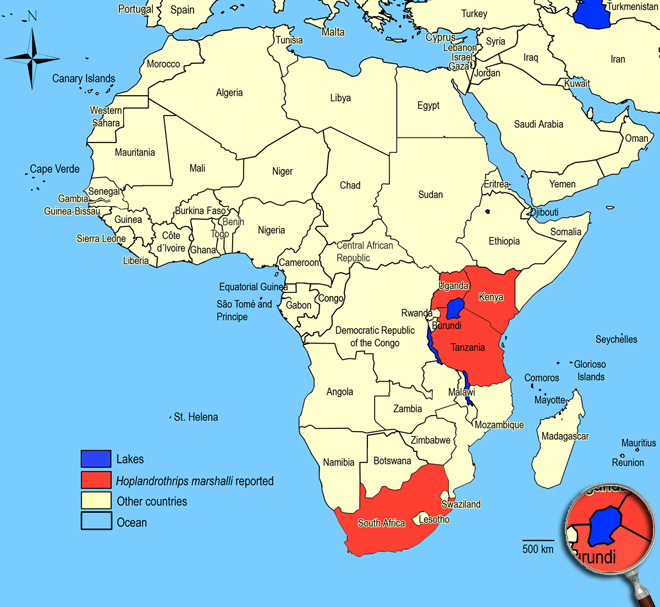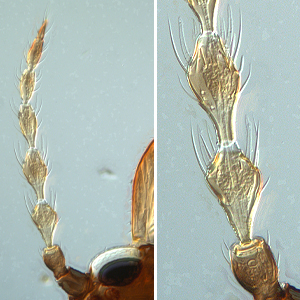Hoplandrothrips marshalli Karny, 1925
Phlaeothripinae, Phlaeothripidae, Tubulifera, Thysanoptera
Figures
Fig. 1: 8-segmented antenna, segments III and IV with simple sense cones
Fig. 2: Head dorsal with ocellar triangle
Fig. 3: Pronotum
Fig. 4: Meso- and metanotum
Fig. 5: Tergite I, pelta
Fig. 6: Fore- and hind wing, fore wing distal region
Fig. 7: Tergites III and IV
Fig. 8: Tergites VIII-X
Fig. 9: Tergites IX and X (= tube)
Introduction and recognition
Hoplandrothrips marshalli is widespread throughout East Africa and induce leaf roll galls on coffee (Coffea arabica). Both sexes fully winged. Body and legs dark brown; all tarsi yellow with a blackish spot (Fig. 6); antennal segment II yellowish brown at extreme apex, III-VI yellow, VII yellowish at base (Fig. 1); fore wings brownish infumate (Fig. 6). Antennae 8-segmented; segment III with 3 and IV with 4 large sense cones. Head longer than wide (Fig. 2); projecting slightly in front of eyes; wider across cheeks than across eyes; cheeks with at least 1 seta-bearing small tubercle in basal third (mostly 3 laterally); surface reticulate; postocular setae wide apart and as long as dorsal length of compound eye or longer; maxillary stylets retracted to eyes, about one fifth of head width apart, maxillary bridge absent (Fig. 2). Pronotum reticulate; with 4 pairs of dark, very stout and blunt major setae (Fig. 3), epimeral suture complete. Metanotum sculptured with longitudinal reticulations medially (Fig. 4). Fore tarsus with slender tooth. Fore wings weakly constricted medially; with 11-14 duplicated cilia (Fig. 6). Pelta reticulate (Fig. 5); tergites II-VII with 2 pairs of sigmoid wing-retaining setae (Fig. 7), also marginal setae S1 with broadly expanded asymmetric apex; tergite IX setae S1 capitate, about half as long as tube (Fig. 8 and 9).
Male varying in size; fore femora swollen and with 1 or 2 short, acute teeth at inner apex, fore tarsal tooth large; sternite VIII with a small glandular area.
Taxonomic identity
Species
Hoplandrothrips marshalli Karny, 1925
Taxonomic history
-
Common name
Coffee leaf-rolling thrips
Present taxonomic position
Family: Phlaeothripidae Uzel, 1895
Subfamily: Phlaeothripinae (Uzel) Priesner, 1928
Genus: Hoplandrothrips Hood, 1912
Genus description
The genus Hoplandrothrips Hood, 1912
More than 100 species are now included in this genus worldwide, most of them fungus-feeders on dead branches and dead leaves. However, there is a group of species in Africa that induce leaf roll galls on shrubby plants, and one of these Hoplandrothrips marshalli, is a minor pest of coffee in East Africa (Mound & Kibby 1998). There are a few identification keys available, Stannard (1968) provided a key to seven species from Illinois, and Mound & Marullo (1996) a key to 18 Neotropical species. The genus has cheeks with at least 1 stout bristle-bearing tubercle, 3 sense cones on antennal segment III and 4 on segment IV, no prosternal basantra, and males usually with a stout tubercle at inner apex of fore femur.
Species description
Typical key character states of Hoplandrothrips marshalli
Coloration
Body color: mainly brown to dark brown
Antennae
Number of antennal segments: 8
Segment III - number of sense cones: 3
Segment IV - number of sense cones: 4
Form of sensorium on antennal segments III and IV: emergent and simple on segments III and IV
Head
Maxillary stylet position: about one fifth of head width apart
Maxillary bridge: absent
Postocular setae: as long as dorsal length of compound eye or a little longer
Cheeks: with stout bristle-bearing tubercle
Prothorax
Number of pairs of elongate pronotal setae: 4
Prosternal basantra: absent
Epimeral suture: complete
Wings
Fore- and hind wings: present and more than half as long as abdomen
Fore- and hind wing surface: not covered with microtrichia, smooth
Fringe cilia arising: not from sockets
Fore wing duplicated cilia: present
Fore wing veins: absent
Fore wing shape: mainly parallel sided or margins run continuously towards each other
Fore wing color: uniformly pale or weakly shaded
Fore wing extreme apex color: pale
Legs
Fore tarsus: with a tooth near apex
Abdomen
Abdominal tergites III to V: with 2 pairs of sigmoid curved wing-retaining setae
Abdominal segment 10: complete tube in both sexes

Similar or related species
Compared to other members of Phlaeothripidae, Hoplandrothrips marshalli has cheeks with at least 1 seta-bearing tubercle in basal third or 3 pairs laterally, on head the maxillary stylet is about one fifth of head width apart, and postocular setae are as long as dorsal length of eye or a little longer. All other species within this key have no seta-bearing tubercle on cheeks. On head of Aleurodothrips fasciapennis the maxillary stylet is more than half of head width apart, and postocular setae are shorter than distance of the setal base from the compound eye. Karnyothrips flavipes, species of Gynaikothrips and Haplothrips have a maxillary stylet that is about one third of head width apart, and the length of postocular setae is about half to nine tenths as long as compound eye. Hoplandrothrips marshalli as well as Karnyothrips flavipes, species of Gynaikothrips and Haplothrips have a mainly brown body color, uniformly fore wings and tergites II-VII each with 2 pairs of wing-retaining setae (only Aleurodothrips fasciapennis with a bicolored body, fore wings with transverse alternating bands of dark and light, and tergites II-VII each only with 1 pair of wing-retaining setae). Hoplandrothrips marshalli as well as Aleurodothrips fasciapennis and species of Gynaikothrips have neither a maxillary bridge nor a prosternal basantra (Karnyothrips flavipes and species of Haplothrips with maxillary bridge and prosternal basantra). Like Karnyothrips flavipes, species of Gynaikothrips and Haplothrips (Haplothrips) gowdeyi, Hoplandrothrips marshalli has duplicated cilia on posterior margin of fore wing (Aleurodothrips fasciapennis and Haplothrips (Trybomiella) clarisetis without duplicated cilia on posterior margin of fore wing).
Biology
Life history
Most of the life-cycle is spent inside the rolled leaves, although presumably pupal stages are spent in the soil. The nymphs are pale yellow, and the adults are dark brown. The details of the life-cycle of this pest are not well known (Hill 1983).
Host plants
Coffee (Coffea arabica).
Vector capacity
None identified, but possible mechanical distribution of phytopathogenic fungi and bacteria.
Damage and symptoms
Infested leaves curl upwards into a roll in which the thrips live and feed. Infestations are more common under shade, where occasionally a tree will have many curled leaves (Hill 1983).
Detection and control strategies
-
Additional notes
-
Biogeography
East Africa. Kenya,
Tanzania,
Uganda (Najunga).
African countries where Hoplandrothrips marshalli has been reported

The species Hoplandrothrips marshalli was not observed in surveys undertaken in East Africa on vegetables and associated weeds and crops.
Please click here for survey sites of all observed thrips species of Kenya, Tanzania and Uganda.

Bibliography
Hill D (1983). Agricultural insect pests of the tropics and their control, (2nd edition), Cambridge University Press, Cambridge, 746 pp
Hood JD (1912). Descriptions of new North American Thysanoptera. Proceedings of the Entomological Society of Washington. 14: 129-160
Karny H (1925). On some tropical Thysanoptera. Bulletin of Entomological Research. 16 (2): 125-142
McNutt DN (1975). Pests of coffee in Uganda, their status and control. International Journal of Pest Management. 21 (1): 9-18
Mound LA & Kibby G (1998). Thysanoptera: An identification guide, (2nd edition). CAB International, Wallingford and New York, 70 pp
Mound LA & Marullo R (1996). The thrips of Central and South America: An introduction (Insecta: Thysanoptera). Memoirs on Entomology, International, Vol. 6. Associated Publishers, Gainsville, 487 pp
Palmer JM (1990). Identification of the common thrips of Tropical Africa (Thysanoptera, Insecta). Tropical Pest Management. 36 (1): 27-49
Palmer JM, Mound LA & du Heaume GJ (1989). 2. Thysanoptera, 73 pp. In Betts CR [ed.], CIE Guides to insects of importance to man. CAB International, Wallingford, Oxon, UK
Stannard LJ (1968). The Thrips, or Thysanoptera, of Illinois. Illinois Natural History Survey Bulletin. 29 (4): 215-552
----
Web links
Mound´s Thysanoptera pages
Thysanoptera Checklist
ICIPE Thrips survey sites
UNI Halle & Thrips sites
Thrips of California












